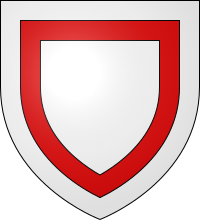Alexander de Baliol facts for kids
Quick facts for kids
Alexander de Baliol
|
|
|---|---|

Coat of arms as Lord of Cavers
Argent, an orle gules |
|
| Chamberlain of Scotland | |
| In office 1287–1294 |
|
| Preceded by | John de Lindsay |
| Personal details | |
| Born | c.1246 |
| Died | c.1309 |
Alexander de Baliol lived from about 1246 to 1309. He was a powerful noble from both England and Scotland. He held the important job of Chamberlain of Scotland for a time. This role was like a chief financial officer for the country.
Contents
Who Was Alexander de Baliol?
Alexander was a member of the important Baliol family. This family was well-known in both England and Scotland. He was also known as the Lord of Cavers.
Early Life and Military Service
In 1270, Alexander de Baliol was first mentioned in Scottish records. He was called the 'Lord of Cavers' then. Seven years later, he was asked to join King Edward I's wars in Wales.
Alexander also took part in a big tournament in France. This event was held for Louis IX of France. His family crest was recorded there. He later joined the Eighth Crusade. This was a religious military journey. He also went on another crusade with his uncle, Eustace de Balliol.
Important Roles in Scotland
In 1284, Alexander was one of the Scottish barons. They promised to accept Margaret, the Maid of Norway as queen. This would happen if King Alexander III had no male children. In the same year, he was called to join King Edward's army. This shows he still owned land in England.
In 1287, Alexander became the Chamberlain of Scotland. He took over this job from John Lindsay. The Chamberlain was in charge of the country's money. Two years later, he helped with talks for the Treaty of Salisbury. This treaty was signed in 1289. It said that Edward, the Prince of Wales, would marry Margaret. King Edward I also agreed that Scotland would stay independent.
However, Margaret died before the marriage. King Edward I then ignored his promises.
Challenges and Later Years
In 1291, Alexander and his wife, Isabella de Chilham, got permission from King Edward. They could stay in Scotland for a year. Alexander continued as Chamberlain even when King Edward I took control of Scotland. This happened during a dispute over who would be the next Scottish king. In 1292, some Scottish records were given back to Alexander.
Alexander was last mentioned as Chamberlain in 1294. He might have lost his job because of arguments between King Edward and John Baliol. In 1296, King Edward forced John Baliol to give up his crown. Alexander was captured at the Battle of Dunbar in 1296. He was only set free when he agreed to fight for King Edward I in a war in Flanders.
Alexander seemed to have been held captive with his relative, John Baliol. In 1297, King Edward took control of Alexander's lands. This included the church of Cavers. Between 1298 and 1301, Alexander fought on the English side. This was during the war with Scotland. He also owned lands in Kent, England.
In 1300, Alexander Baliol was with King Edward I at the siege of Caerlaverock. By 1303, he seemed to be changing sides again. His belongings in Kent, Hertfordshire, and Roxburghshire were seized. This was done by John de Bretagne.
Alexander held his lands in Kent, like Chilham Castle, through his wife, Isabella de Chilham. They had three sons: Alexander, Thomas, and William.
The exact date of Alexander's death is not known. He was called to all of King Edward I's parliaments until 1307. He was not called to any of King Edward II's parliaments. So, he likely died soon after King Edward II became king.
Images for kids


